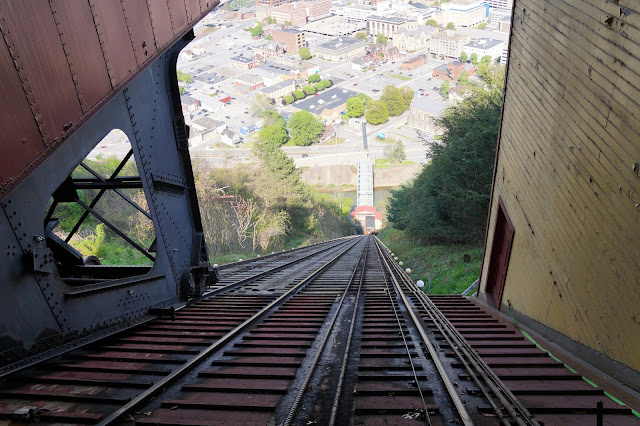We have continued to stay in touch and called them when we knew our itinerary on this trip. They live in Johnstown in western Pennsylvania. The Friday before Mothers Day we arrived at Bill and Joy’s lovely, old home (which is over 100 years old) and started talking non-stop.
None of Bill and Joy's families were able to be home for Mother's Day and our families were back in Western Canada. We stayed an extra day so Joy and I could celebrate being Mothers together. When our children were babies and toddlers we were both part of an informal Young Mothers Group in our church.
On Mother's Day we enjoyed a picnic at Joy's family resort area. Along with extended family, she grew up there among lovely old cottages in the forest.
AFter a hundred years, only the stone fireplaces of some cottages remain.
The Allegheny Mountains of western Pennsylvania are steep and rugged and in the 1800s created an impassable barrier to travel between Pittsburgh and Philadelphia.
In 1834 the Allegheny Portage Railroad provided the final link in a series of canals and railroad lines creating better access to western Pennsylvania communities. The system of stationary steam engines, mules, horses, and later locomotives, hauled canal boats carrying people, manufactured goods, and raw materials, up and over the mountains.
Railroad cars, bearing loaded canal boats, were pulled up and lowered down an incline by a continuous rope, driven by stationary steam engines. There were ten such inclines where freight and passenger cars were counterbalanced on the upward and downward tracks. The concept was very complicated and ingenious but harrowing for passengers envisioning runaway cars.
From 1852 until the 1980s steel production was the lifeblood of Johnstown. The city, built on a flood plane, was blessed with an abundance of deposits of iron ore, coal, wood and a water supply. In the late 1800s Johnstown attracted the best and brightest minds in the industry.
Prosperity brought wealthy industrialists to the area’s scenic South Fork Fishing and Hunting Club. The resort was created around an old reservoir held in check by the South Fork Dam. It was not well maintained. On May 31st, 1889 the dam broke unleashing 20 million tons of water into the Little Conemaugh Valley.
Reaching heights of 70 feet, the wave of destruction roared down the valley crushing and dragging everything is its path. Fourteen miles and 57 minutes later, the 36-foot wave hit Johnstown at 40 miles an hour.
Most people in the town of 30,000 had no warning. Those caught in the wave were swept away by a torrent of oily, yellow-brown water surrounded by tons of grinding debris that crushed some and provided rafts for others.
2,209 people died and thousands more were injured and homeless. Five days after the flood Clara Barton, the founder of the American Red Cross, arrived in Johnstown for the first test of the new organization. With 50 doctors and nurses she set up hospital tents, built six “Red Cross Hotels” for the homeless, and distributed food, clothing and medicine.
After the flood, Johnstown’s manufacturing centers were rebuilt and the city entered a new era of growth and prosperity. As a direct result of the 1889 flood the hilltop residential suburb of Westmont was established. Opened in 1891 The Inclined Plane was the steepest (35* incline) vehicular inclined plane in the world. It allowed residents to live in safety above the flood-prone valley.
The principal is the same as the Allegheny Portage Railroad. Keeping each car level, a cable pulls the cars up and down the incline.
In 1936 Johnstown suffered another flood when a quick spring thaw combined with intense rain. Some two dozen people died when 17 feet of water submerged the downtown area.
In 1938 an extensive channel improvement program deepened, realigned and reinforced over nine miles of channels through the city.
In 1977 a freak storm stalled over Johnstown resulting in a twelve-inch downpour. Rivers and streams overflowed and several small dams failed, causing 85 deaths.
The people of Johnstown are resilient and determined to maintain their community despite so many acts of nature and man.





















Fascinating.
ReplyDeletewhen we think of Pennsylvania, we think of the worst roads on the continent - unfortunately didn't see much more than that.
ReplyDeleteWere you driving "South to North" or West to East"?
ReplyDeleteRalph & Linda, It was a wonderful visit we had together after all those years. Thank you so much for your visit and thank you for the wonderful travelog of an area of the USA where very few people ever visit. Our roads are indeed precarious...very unlike the straight roads of prairie Alberta where we once lived or even mountain roads of Alberta or British Columbia where we also lived.. We are looking forward to your next visit!
ReplyDelete